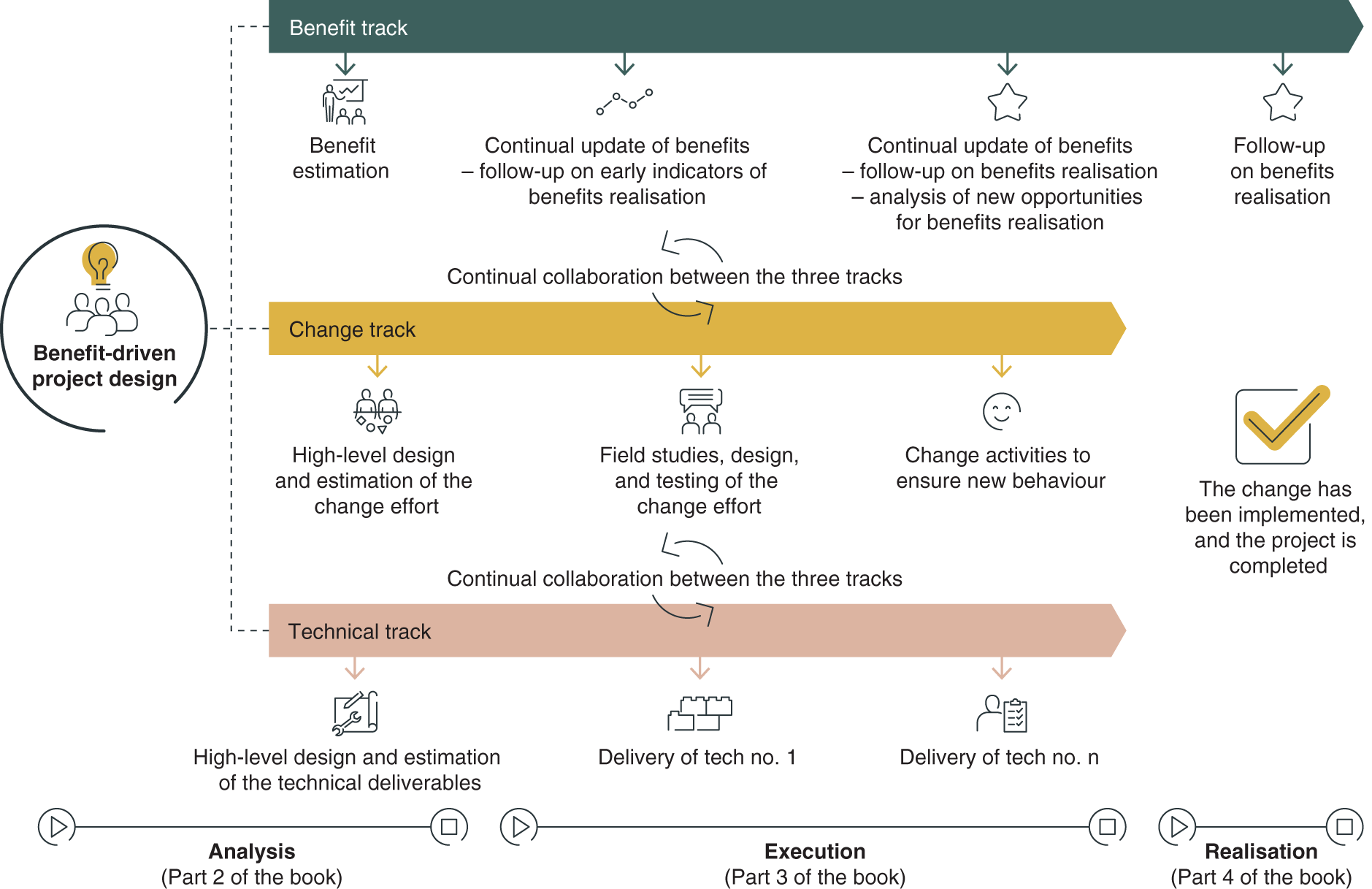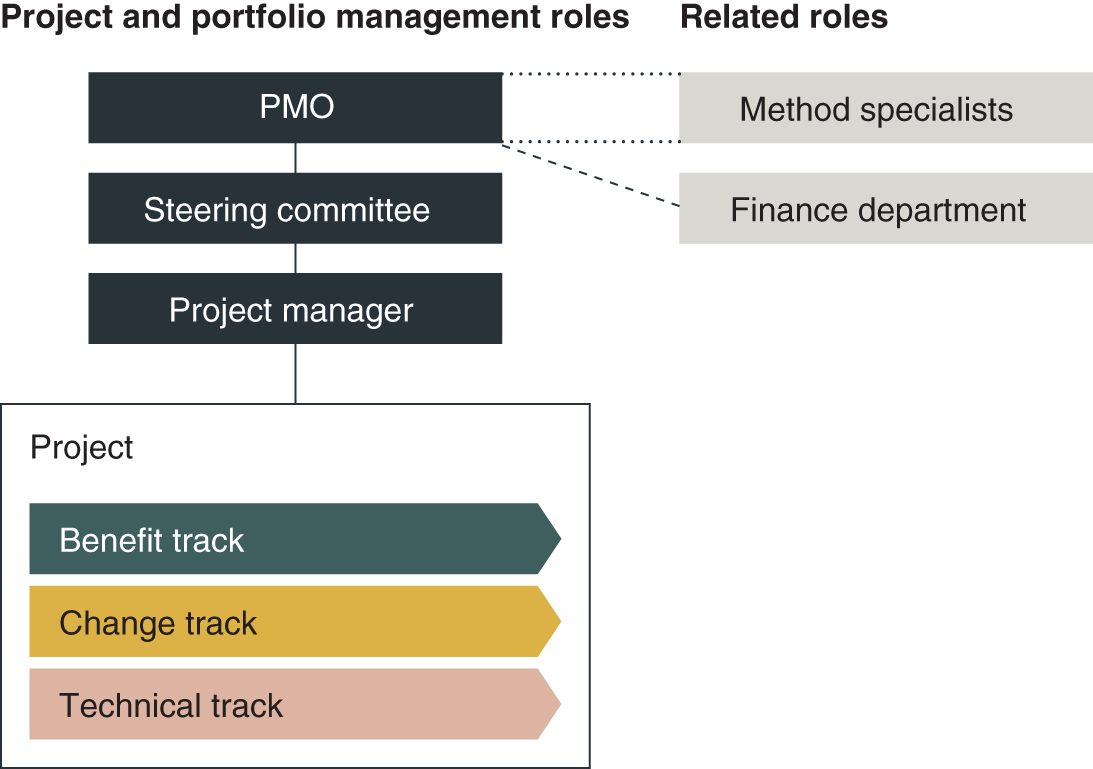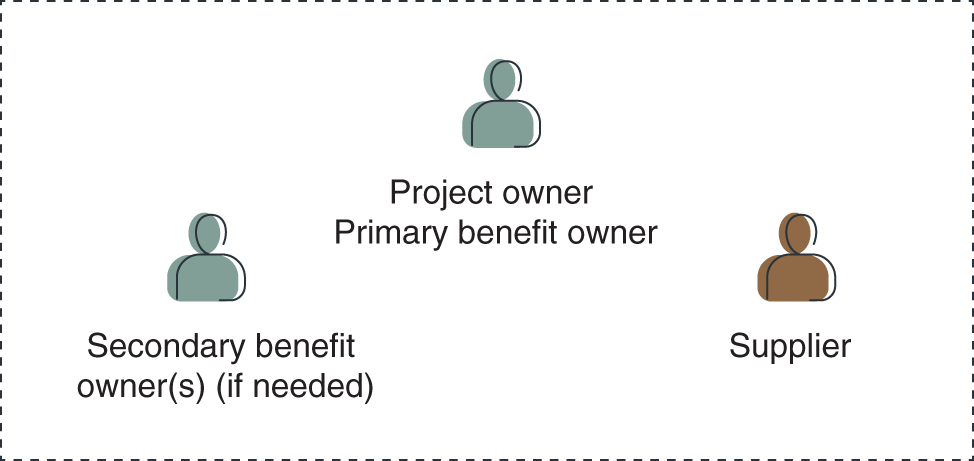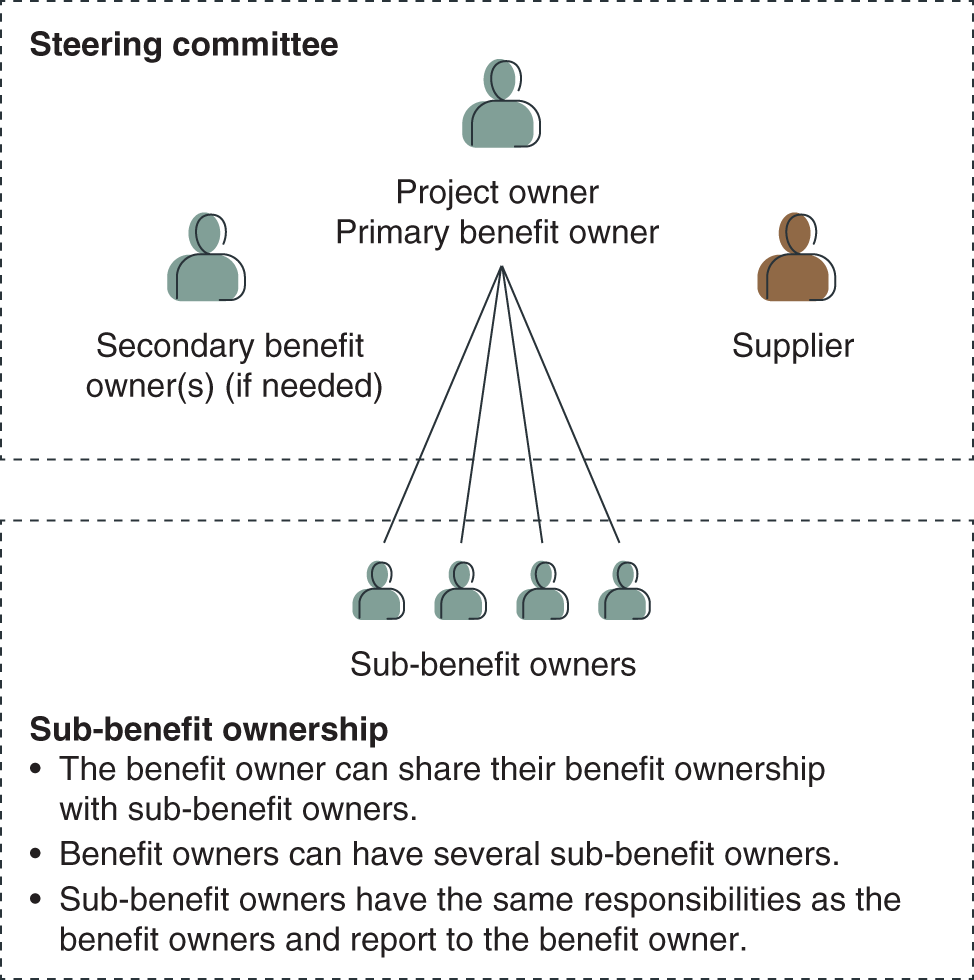1
Introduction to the Book
Benefits realisation is a method for creating the greatest possible value from a change project. It is a new way of looking at and working with business change projects and other efforts needed to develop an organisation.
The current focus within both public and private sectors on implementing enablers, rather than on realising benefits and achieving the vision or end goal, is so widespread and deep rooted that it needs a clear process and sustained effort to change.
Gerald Bradley, author of Benefit Realisation Management (2010)
Benefits realisation is about focusing on the purpose and benefits we want to achieve and the behavioural change it will require of our colleagues. The method enables us to initiate our projects by designing business change projects (which will from this point on be referred to as ‘projects’) to create the prerequisites for realising our desired purpose and benefits.
New Behaviour Creates Benefits
The benefits realisation method prioritises behavioural change as the decisive and triggering factor for creating value. The method shows how our colleagues' new way of working creates the desired value. This ability to couple benefits and new behaviours is key to the success of a project. Changing our colleagues' behaviour often requires help. This help is what projects are all about. It could be helping colleagues to continue working in a new way or to overcome their resistance to change. But it could also be helping to support our colleagues in attaining new competencies or create new technical deliverables in the form of processes, IT systems, or products available. The processes, the IT system, and the products are essential but are only part of the means – not the goal. The goal is benefits realisation. In addition to the technical deliverables, we must also build competencies and anchor the new behaviour before reaching our goal.
Among companies and public organisations, there is an ever-growing awareness that value creation is about more than just producing deliverables. Words such as ‘value’, ‘effect’, and ‘benefits’ have found their way into our language when we talk about topics such as projects, creating a greater focus on what value we need to create for our organisation, our customers, or the citizens we want to help. And yet, the practical approach to projects is still characterised by Gerald Bradley's quote above: we focus far too much on deliverables and far too little on change and benefits. There is a growing awareness among project practitioners of the importance of benefits realisation, and a common language for it is steadily developing. However, most organisations still need to define what a focus on value means and integrate a practical approach to benefits realisation and change as part of the way we develop our organisations.1 That is what this book aims to do.
The Structure of the Book
The book consists of five parts. Each part details how to get more out of your projects. You are already well on your way with Part 1, which gives you an overview of key concepts, roles, and introduces the benefit-driven change model that visualises what it takes to create value during a project's lifetime.
The first purpose of the book is to provide a practical and case-based guide on how your organisation can get more value out of your projects. This is detailed in Part 2 and Part 3 of the book. To make it easy for you to apply the content of the book to your project or organisation's project model, the structure of the book reflects the main phases of most projects: an analysis phase (Part 2 of the book) and an execution phase (Part 3 of the book). The book's points are elaborated on through two cases from Nykredit (a large Danish financial company) and the University of Copenhagen, respectively, and detailed descriptions of the most important workshops and activities. Whether your organisation's approach to producing technical deliverables is agile, waterfall, PRINCE2, scrum, or SAFe (scaled agile framework), the way we work with benefits realisation and change management does not change significantly. Nevertheless, as it turns out, the combination with SAFe requires a little extra attention. I will go into this in Part 3.
While Parts 2 and 3 illustrate what it takes to realise more benefits at the project level, Part 4 of the book shows how the benefit-driven portfolio management office (PMO) function can ensure benefits realisation across the portfolio. As soon as we broaden the use of a practical and structured approach to benefits realisation and behavioural change, we get new data on both benefits and the change effort. This enables us to manage and prioritise our portfolio in order to make decisions at the portfolio level that will maximise our benefits realisation.
Part 5 details the book's second purpose: making the benefits realisation method a part of your way of working with projects. There is more than one way of doing that, but the most successful approaches to implementing the benefits realisation method are similar in several ways. One of the organisations that have been successful in implementing the benefits realisation method is Ørsted. Ørsted is a large international renewable energy company, and the company is used as a case study on how to implement the benefits realisation method successfully. But first, you will get a brief introduction to what benefits are and a presentation of the benefit-driven change model, which sets the overall framework for benefits realisation and behavioural change. Additionally, I will introduce a number of the concepts I use along the way in the book.
The Benefit-driven Change Model
The benefits realisation method is an addition to our current technically focused (business change) projects. An additional layer that contains a practical approach to benefits realisation and behavioural change, building on an often well-established and good practice of producing technical deliverables.
In most projects, technical deliverables are just as important as changing behaviour and realising benefits to create the desired value. I will leave it to others to describe the most efficient way of producing technical deliverables and instead focus on how technical deliverables contribute to creating value.
We will use the benefit-driven change model shown in Figure 1.1 to illustrate the tasks a project should include to realise the potential benefits. The benefit-driven change model shows the project from the time its analysis phase is kicked off to after it has been completed. In the analysis phase, we design the project to create value, and the most important step in creating the benefit-driven project design is a benefits realisation workshop. Here we outline the desired benefits and what it takes to realise them. The model shows the three tracks that illustrate the main tasks of the projects, namely the benefit track, the change track, and the technical track.
The Interaction Between the Tracks
The benefit-driven project design is the starting point for the analysis phase (Part 2 of the book), where the content of the three tracks is detailed. Based on that, we will be able to create a business case and decide whether the project should proceed or not. If the project proceeds, the execution phase will require work to be done in all three project tracks as well (Part 3 of the book). Changes in the project's environment and new knowledge make it necessary to continually adjust and optimise all three tracks to maximise the project's benefits realisation. Once the last technical deliverable is produced and the desired behavioural change in the organisation is attained, the project is completed.
The only task in the realisation phase is to follow up on the realisation of the project's benefits. The follow-up on benefits realisation continues until we are confident that value creation is firmly anchored in the business (follow-up on benefits realisation takes place at the portfolio level and is described in Part 4 of the book). In projects with more than one launch, that is more than one effort to anchor a new way of working in the organisation, the follow-up on benefits realisation starts after the first launch when the project is still in the execution phase.

Figure 1.1 The benefit-driven change model.
The Definition of a Benefit
At this point, I have already mentioned the word ‘benefit’ many times. So, before we go any further, it is important to define what a benefit is.
These benefits may, for example, include increased revenue or savings in either time or money. Or they may consist of increased job satisfaction, more subject matter expertise, or a better image. They are typically quantifiable, although the task of quantifying them can be so extensive that it is not feasible in practice. Benefits can be both intentional and unintentional. If one or more stakeholders considers the result of a change as negative, it is a negative benefit.
Indirect Benefits
The benefits that are most often included in a business case are those directly derived from the change implemented by the project. In many cases, projects also create indirect benefits. These are benefits that strengthen the organisation's ability to change, i.e. to create change and realise benefits in the future, although these benefits are often not quantifiable. When an organisation decides to carry out a major project without having the capabilities to succeed, building that capability for change can be unbelievably valuable. In some cases, it may even have greater value than the direct, measurable benefits of the project.
The indirect benefits are typically greatest in large-scale projects or, for example, projects where we also change the organisation's ability to carry out future projects using new methods. Here we should identify and include the indirect benefits in our business case, even though we may not be able to quantify them. In most other projects, the indirect benefits are of minor importance.
The Roles in Benefits Realisation
Before we delve into the practice of realising benefits, it is important to understand the consequences of introducing the benefits realisation method to the various roles in projects.
The book takes an offset in the project organisation and the roles many organisations are already using.
The introduction of the benefits realisation method gives project managers and leaders in the steering committee significantly more responsibility. A practical approach to benefits realisation and change as an additional layer to our projects also impacts the PMO function that facilitates portfolio management.
Many organisations that have already implemented a structured approach to benefits realisation and change have method specialists supporting project managers and steering committee members in performing the new tasks related to realising benefits and change efforts. The method specialist role can be inside or outside the PMO. When the benefits realisation method is fully implemented, there is typically a close coupling of the finance department and the PMO, creating a direct link between realised benefits and the organisation's budgets if the benefits are of a financial nature.
The traditional project organisation has proven to be highly effective at ensuring the production of technical deliverables. Thus, the goal is to expand the roles and responsibilities in the project organisation to make it just as skilled in ensuring organisational change and benefits realisation as when ensuring the production of technical deliverables. The key roles in the project organisation are illustrated in Figure 1.2.
The Role of the PMO Function
A project is either formally or informally part of a portfolio. The role of the PMO is to ensure that the portfolio's benefit potential is realised. To succeed in this, the PMO undertakes several tasks. First, the PMO must facilitate management's prioritisation of the portfolio. It includes establishing a basis for decision-making for prioritisation, which should be based on project data. To do so effectively, it is necessary to govern how decisions are made at the project and portfolio level and balance the capacity available to develop projects. In cases where the PMO is also responsible for providing support to the projects, the responsibility may include providing training and practical assistance to the projects so that project managers and managers can receive coaching, facilitation support, or other project-related services.

Figure 1.2 Key roles in the project organisation.
The Steering Committee and the Role of the Benefit Owner
The definition of a benefit as ‘a result of a change that is considered positive by one or more stakeholders’ indicates an owner of the benefits. A person who is prepared to take ownership for realising a benefit on behalf of themselves or a group of stakeholders. That person is called a benefit owner.
The benefit-driven steering committee has two roles, as illustrated in Figure 1.3: the benefit owner role and the supplier role. There can be more than one benefit owner in the steering committee, and the leader of the steering committee is called a project owner. The project owner is the primary benefit owner, i.e. the benefit owner who has the most at stake. This person is also responsible for the overall business case in addition to the responsibility for benefits realisation.

Figure 1.3 The benefit-driven steering committee.
The benefit owner role is new and, at the same time, essential. The benefit owner is a person or representative of the people owning the project benefits. Thus, the benefit owner defines the desired benefits, follows up on whether they can still be realised, looks for new opportunities for realising benefits, and reports on the benefits to the PMO after the project is completed.
The benefit owner has the overall responsibility for ensuring that the change driving the benefits realisation process will occur. The benefit owner also acts as a promoter of the change and is thus highly active in the project.
In projects or programmes where benefits are realised across organisations, sharing the benefit ownership with sub-benefit owners makes good sense. It anchors the change efforts and benefits locally and eases the workload of the steering committee. The number of participants in the steering committee can thus be kept at a level that makes it possible to get together and make decisions at short notice. Figure 1.4 outlines the delegation of benefit ownership.
Additionally, the benefit owner usually supplies resources to the benefit track and change track coming from their part of the organisation.

Figure 1.4 Delegation of benefit ownership.
Large-scale projects often require IT or technical deliverables from internal or external suppliers. It is important to maintain the traditional supplier role for the steering committee to ensure the efficient production of technical deliverables. The responsibility of a supplier in the steering committee is to make sure that the technical deliverables meet the agreed requirements for time, quality, and cost.2
The Project Manager Role
Project managers face changes that alter what a project contains and the criteria for doing well in the project manager role. The steering committee no longer has only the management responsibility for a project producing technical deliverables. Likewise, the project manager is not responsible only for managing a team producing technical deliverables. The project manager is responsible for a team that always has an updated picture of what benefits it can realise. The project manager also analyses and executes the organisational change and produces the technical deliverables needed for the benefit owner to realise the benefits.
In order to be successful with benefits realisation in a project, the benefit owners and the project manager must fulfil their new roles. While the role of the benefit owner is primarily about taking greater responsibility for the benefits and change efforts and thus being more involved in the project, it is different for the project manager. The project manager's new role includes a significant expansion of the responsibilities and subject matter area that projects now include. Benefits realisation and organisational change are crafts: it takes time to get good at them.
Some project managers will take their project management skills to a new level and become specialists in working with benefits realisation and change efforts. Others will become project managers of larger projects containing a series of subprojects with more specialised project managers or project participants responsible for technology development or organisational change. In contrast, others will specialise as, for example, IT project managers or change managers. Regardless of which path the organisation and the individual project manager choose to take, it is crucial for the project's benefits realisation that the new tasks in the project manager role are performed.
Method Specialists
Visualising the project's three tracks from the benefit-driven change model creates a need to implement benefits realisation and change management in the way we work with projects. This gives rise to expanding the project method framework, so the new benefit and change methods get an owner and are continually updated.
Table 1.1 Roles, responsibilities and tasks in the benefit realisation process.
| Role | Benefit realisation responsibility | Benefit realisation task | Who in the organisation |
|---|---|---|---|
| Top management | Responsible for realising the strategy, including maximising the benefit realisation through the projects in the portfolio. | Makes the decisions that realise the organisation's strategy and maximise benefit realisation. | Company management. Either the top management or possibly the management of a business unit. |
| PMO/ portfolio office | Responsible for facilitating and implementing the top management's prioritisation of the portfolio. | Prepares the basis for decision-making and ensures the start-up of the projects that give the organisation the greatest possible benefits measured against the objectives laid down in the strategy. Ensures that different projects are not chasing the same benefits and collects data for benefit realisation and change at the portfolio level. | PMO/portfolio unit. |
| Project owner/primary benefit owner (steering committee role) | Accountable for the entire project and business case, including benefit realisation. | Ensures benefit realisation and organisational change for the entire project, including that any shared benefit realisation responsibility is firmly rooted in sub-benefit owners who are not part of the steering committee. | Top or senior manager in the part of the business where (most of) the benefits are realised. |
| Benefit owner (steering committee role) | Accountable for realising benefits and for the organisational change that benefit realisation requires. Supplier of resources for the change effort. | Ensures benefit realisation and is a promoter of the organisational change in his or her part of the business. In addition, the benefit owner must validate that the benefits remain achievable during the project and monitor opportunities for new benefits. Reports on benefit realisation during the project and after the project is completed. | Manager in the part of the business where (most of) the benefits are realised. |
| Supplier (steering committee role) | Accountable for the technical deliverables meeting the requirements of the business so that the business can realise benefits. | Ensures that technical deliverables are delivered at the agreed time, quality and cost. | Head of IT department, external supplier. |
| Project manager | Responsible for managing the project so that it creates the possibility of benefit realisation. | Day-to-day management of the project, including management of the benefit track, change track and technical track. Supports the benefit owner by continuously helping to identify opportunities that could increase benefit realisation and risks that could reduce it. | Typical part of the business or a central project management organisation. |
| Finance department | Responsible for transferring realised and planned benefits into the organisation's budgets. | Ongoing dialogue with the PMO function about future budgeting based on the expected future benefit realisation and actual adjustment of budgets based on realised benefits. | The finance department. |
| Method specialists | Ownership of and responsible for continuous development of the benefit realisation and change methods, including training in and support for the use of the methods. | Ensures continuous updating of methods, competency development and ad hoc support for project managers and steering committee members. | Experienced project manager who also works as a method specialist or a PMO employee with project experience. |
Anchoring benefits realisation and behavioural change among method specialists, who master the new methods and can pass it on in the organisation, has proven to be an effective way to implement benefits realisation and behavioural change. After an implementation, many organisations choose to retain the method specialists, partly to ensure the future development of the methods and partly to continually improve the competencies of new and current project managers. Thus, the method specialists provide a permanent service offering training, coaching, and practical facilitation assistance to project managers and benefit owners. Being a method specialist is often a small part of their job alongside their primary role as, for example, a project manager.
In Table 1.1, you will find a complete overview of the roles in and around the project.
You now have the foundation to get started with what this book is all about: to provide you with a practical and case-based guide to creating more value through your projects. We begin where the project has just been kicked off.
Notes
- 1 University of Oxford, Saïd Business School, and Implement Consulting Group (2015–2020). This study shows that most organisations today formulate targets for the desired outcomes of their projects. However, only one in four organisations puts figures on what the project should achieve, and less than one-fifth follow up on whether the benefit targets are achieved.
- 2 The traditional supplier role is described in PRINCE2 (Office of Government Commerce 2009).
